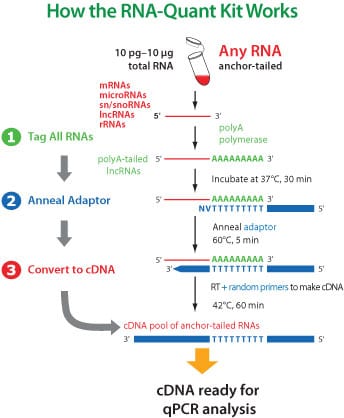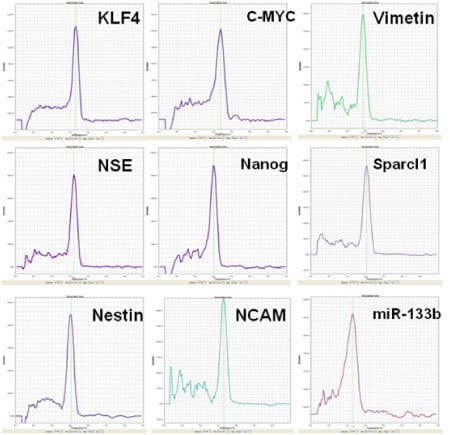Neural Lineage qPCR Profiler
Products
Overview
Overview
Easily study neural differentiation using qPCR With qPCR primers for a carefully curated set of mRNA, miRNA, and lncRNA neural differentiation markers and SBI’s sensitive and reliable RNA-Quant™ cDNA Synthesis Kit, our Neural Lineage qPCR Profiler simplifies your neural development and lineage studies. The Neural Lineage qPCR Profiler is a comprehensive system for characterizing the different stages of human neural development, and discriminating between terminally differentiated neural cell types. The system can simultaneously quantitate relative expression level differences between two or more samples for 95 separate markers. All markers included in the qPCR Profiler have been carefully selected from the published literature for their roles in neural differentiation or cell-specific expression in different types of neural cells, and all primers have been validated using RNAs from relevant tissues, including human fetal brain, human adult brain, iPSCs, neural precursor cells, and medulla oblongata.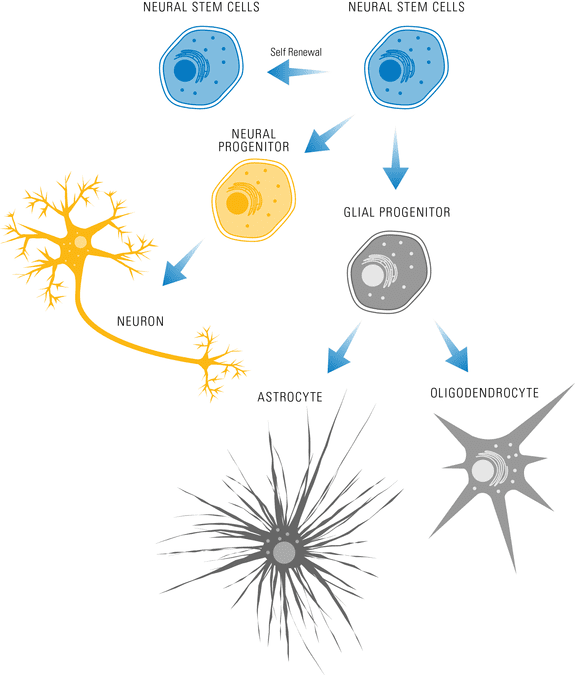 About the included RNA-Quant cDNA Synthesis Kit
With a single cDNA synthesis reaction, you can efficiently prepare all of the RNAs in your sample for real-time qPCR using the RNA-Quant cDNA Synthesis Kit. Unlike other cDNA synthesis kits which can only prepare one or two classes of RNAs for qPCR, the RNA-Quant Kit enables qPCR measurement of many classes of RNA from a single cDNA synthesis reaction. The kit includes three endogenous RNA reference qPCR assays as for human and mouse samples—miR-16, Y RNA lncRNA, and GAPDH mRNA.
An all-in-one cDNA synthesis kit
About the included RNA-Quant cDNA Synthesis Kit
With a single cDNA synthesis reaction, you can efficiently prepare all of the RNAs in your sample for real-time qPCR using the RNA-Quant cDNA Synthesis Kit. Unlike other cDNA synthesis kits which can only prepare one or two classes of RNAs for qPCR, the RNA-Quant Kit enables qPCR measurement of many classes of RNA from a single cDNA synthesis reaction. The kit includes three endogenous RNA reference qPCR assays as for human and mouse samples—miR-16, Y RNA lncRNA, and GAPDH mRNA.
An all-in-one cDNA synthesis kit
- Tail and tag all RNAs for cDNA synthesis
- Obtain full RNA coverage for any purpose
- Profile any RNA—mRNA, miRNA, lncRNA, sn/snoRNA, rRNA
How It Works
How It Works
Using the Neural Lineage qPCR Profiler
First, prepare RNA for qPCR using the RNA-Quant cDNA Synthesis Kit
The poly-A tailing and tagging method in the RNA-Quant System generates cDNA that is highly unique and, when used with the 3’ Universal Reverse Primer, does not produce any signal in the absence of reverse transcriptase or lead to the detection of any residual genomic DNA. The result is zero background for RNA profiling with complete confidence.
- Tag all small RNAs with a poly-A tail
- Anneal an oligo-dT adaptor
- Reverse transcribe to create first-strand cDNA
Your final product will be a cDNA pool of anchor-tailed miRNAs that are ready for qPCR.
Then conduct qPCR assays using the 96-well primer array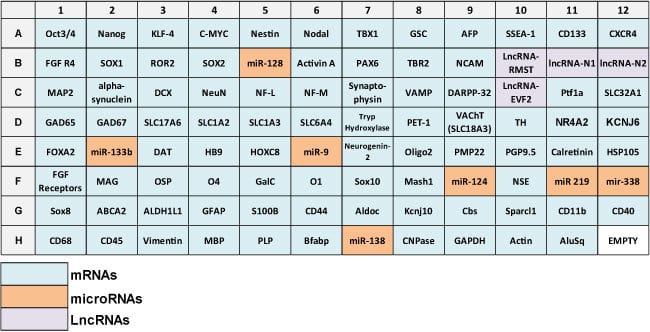
Primers for mRNAs and lncRNAs were designed using sequence information from NCBI and were verified to possess no significant homology to off-target sequences or known murine sequences. Each mRNA and lncRNA primer set amplifies a DNA segment of 100 – 120 nucleotides (nt) in length.
For mature miRNAs in the 19-24 nt size range, the forward primer consists of the target miRNA sequence (obtained from miRbase) paired with SBI’s proprietary universal reverse primer, which is homologous to the adapter of the anchored oligo-dT that is added by the RNA-Quant Kit.
The array plate also includes GAPDH, β-actin, and AluSeq as internal normalization controls. Additional details including the associated lineage for each marker and gene accession numbers for primer design, can be found in the Excel document, “Neural qPCR profiler data analysis template.”
Supporting Data
Supporting Data
Profiling neural development with the Neural Lineage qPCR Profiler
The Neural Lineage qPCR Profiler assays are highly specific
Figure 1. The Neural Lineage qPCR Profiler assays are highly specific. Individual primer set assays using the Neural Lineage qPCR Profiler on total RNA isolated from neuronal tissue show a single peak during dissociation melt curve analysis, demonstrating the high specificity of the kit.
The Neural Lineage qPCR Profiler can identify pluripotency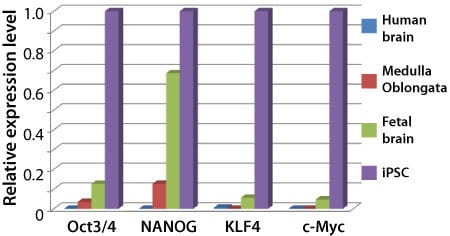
Figure 2. The Neural Lineage qPCR Profiler can identify pluripotency. Analysis of total RNA derived from adult human brain cells, medulla oblongata cells, fetal human brain cells, and iPSCs using the pluripotency markers Oct4, Nanog, Klf4 and c-Myc from the Neural Lineage qPCR Profiler only show strong signal for the less differentiated tissues, as expected.
The Neural Lineage qPCR Profiler easily distinguishes iPSCs, neural stem cells, and differentiated neurons 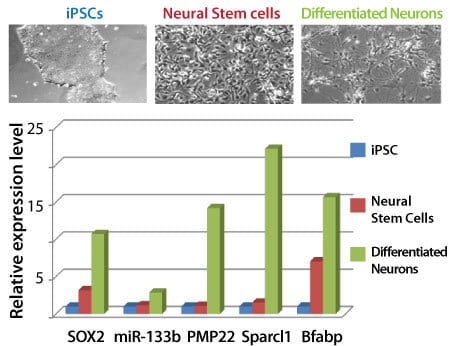
Figure 3. The Neural Lineage qPCR Profiler easily distinguishes iPSCs, neural stem cells, and differentiated neurons.
The Neural Lineage qPCR Profiler distinguishes neuronal lineages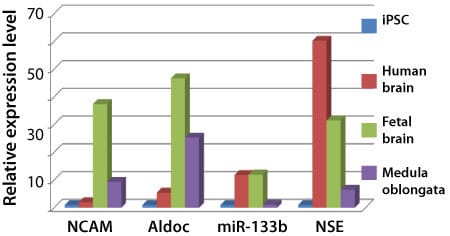
Figure 4. The Neural Lineage qPCR Profiler distinguishes neuronal lineages. NCAM (Neural Cell Adhesion Molecule) is a neural precursor marker, ALDOC (Aldolase C, Fructose-Bisphosphate) is a marker for astrocytes, miR-133b is a marker for dopaminergic neurons, and NSE (Neuron Specific Enolase) is a marker for oligodendrocytes.
FAQs
Resources
Related Products
Citations
Products
Overview
Overview
Easily study neural differentiation using qPCR With qPCR primers for a carefully curated set of mRNA, miRNA, and lncRNA neural differentiation markers and SBI’s sensitive and reliable RNA-Quant™ cDNA Synthesis Kit, our Neural Lineage qPCR Profiler simplifies your neural development and lineage studies. The Neural Lineage qPCR Profiler is a comprehensive system for characterizing the different stages of human neural development, and discriminating between terminally differentiated neural cell types. The system can simultaneously quantitate relative expression level differences between two or more samples for 95 separate markers. All markers included in the qPCR Profiler have been carefully selected from the published literature for their roles in neural differentiation or cell-specific expression in different types of neural cells, and all primers have been validated using RNAs from relevant tissues, including human fetal brain, human adult brain, iPSCs, neural precursor cells, and medulla oblongata. About the included RNA-Quant cDNA Synthesis Kit
With a single cDNA synthesis reaction, you can efficiently prepare all of the RNAs in your sample for real-time qPCR using the RNA-Quant cDNA Synthesis Kit. Unlike other cDNA synthesis kits which can only prepare one or two classes of RNAs for qPCR, the RNA-Quant Kit enables qPCR measurement of many classes of RNA from a single cDNA synthesis reaction. The kit includes three endogenous RNA reference qPCR assays as for human and mouse samples—miR-16, Y RNA lncRNA, and GAPDH mRNA.
An all-in-one cDNA synthesis kit
About the included RNA-Quant cDNA Synthesis Kit
With a single cDNA synthesis reaction, you can efficiently prepare all of the RNAs in your sample for real-time qPCR using the RNA-Quant cDNA Synthesis Kit. Unlike other cDNA synthesis kits which can only prepare one or two classes of RNAs for qPCR, the RNA-Quant Kit enables qPCR measurement of many classes of RNA from a single cDNA synthesis reaction. The kit includes three endogenous RNA reference qPCR assays as for human and mouse samples—miR-16, Y RNA lncRNA, and GAPDH mRNA.
An all-in-one cDNA synthesis kit
- Tail and tag all RNAs for cDNA synthesis
- Obtain full RNA coverage for any purpose
- Profile any RNA—mRNA, miRNA, lncRNA, sn/snoRNA, rRNA
How It Works
How It Works
Using the Neural Lineage qPCR Profiler
First, prepare RNA for qPCR using the RNA-Quant cDNA Synthesis Kit
The poly-A tailing and tagging method in the RNA-Quant System generates cDNA that is highly unique and, when used with the 3’ Universal Reverse Primer, does not produce any signal in the absence of reverse transcriptase or lead to the detection of any residual genomic DNA. The result is zero background for RNA profiling with complete confidence.
- Tag all small RNAs with a poly-A tail
- Anneal an oligo-dT adaptor
- Reverse transcribe to create first-strand cDNA
Your final product will be a cDNA pool of anchor-tailed miRNAs that are ready for qPCR.
Then conduct qPCR assays using the 96-well primer array
Primers for mRNAs and lncRNAs were designed using sequence information from NCBI and were verified to possess no significant homology to off-target sequences or known murine sequences. Each mRNA and lncRNA primer set amplifies a DNA segment of 100 – 120 nucleotides (nt) in length.
For mature miRNAs in the 19-24 nt size range, the forward primer consists of the target miRNA sequence (obtained from miRbase) paired with SBI’s proprietary universal reverse primer, which is homologous to the adapter of the anchored oligo-dT that is added by the RNA-Quant Kit.
The array plate also includes GAPDH, β-actin, and AluSeq as internal normalization controls. Additional details including the associated lineage for each marker and gene accession numbers for primer design, can be found in the Excel document, “Neural qPCR profiler data analysis template.”
Supporting Data
Supporting Data
Profiling neural development with the Neural Lineage qPCR Profiler
The Neural Lineage qPCR Profiler assays are highly specific
Figure 1. The Neural Lineage qPCR Profiler assays are highly specific. Individual primer set assays using the Neural Lineage qPCR Profiler on total RNA isolated from neuronal tissue show a single peak during dissociation melt curve analysis, demonstrating the high specificity of the kit.
The Neural Lineage qPCR Profiler can identify pluripotency
Figure 2. The Neural Lineage qPCR Profiler can identify pluripotency. Analysis of total RNA derived from adult human brain cells, medulla oblongata cells, fetal human brain cells, and iPSCs using the pluripotency markers Oct4, Nanog, Klf4 and c-Myc from the Neural Lineage qPCR Profiler only show strong signal for the less differentiated tissues, as expected.
The Neural Lineage qPCR Profiler easily distinguishes iPSCs, neural stem cells, and differentiated neurons 
Figure 3. The Neural Lineage qPCR Profiler easily distinguishes iPSCs, neural stem cells, and differentiated neurons.
The Neural Lineage qPCR Profiler distinguishes neuronal lineages
Figure 4. The Neural Lineage qPCR Profiler distinguishes neuronal lineages. NCAM (Neural Cell Adhesion Molecule) is a neural precursor marker, ALDOC (Aldolase C, Fructose-Bisphosphate) is a marker for astrocytes, miR-133b is a marker for dopaminergic neurons, and NSE (Neuron Specific Enolase) is a marker for oligodendrocytes.


